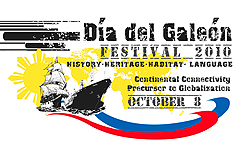Día del Galeón Festival – Manila Galleons Maritime History
 |
|
Image courtesy NCCA
|
The Día del Galeón Festival celebrates the unique journey of the Manila galleons and their place in maritime history – spanning the globe and linking the Philippines with Mexico and Spain. For 250 years (from 1565 – 1815) the Manila galleons were a conduit for global trade and cultural exchange between Europe, the New World and Asia.
In October 2009 UNESCO recognized the unique part the Manila galleons played in the globalization of trade and cultural exchange by declaring 8th October as the international “Día del Galeón” (day of the galleon). Motivated by Senator Edgardo Angara, the Philippine National Commission for Culture and the Arts (NCCA), in conjunction with the embassies of Spain and Mexico, spearheaded the creation of a month-long series of events that will span the traditional galleon trade route through the Philippines.
The Día del Galeón festival runs from 15th September to 11th October and is expected to be an annual event that will entertain and educate Filipinos and rest of the World, and encourage a greater understanding of the impact the Philippines has had on the World of global trade. An international grand celebration is also slated for 12th October in Paris.
The 8th October was chosen by UNESCO as the Dai del Galleon to commemorate the arrival of the first Manila galleon in Acapulco, Mexico, in 1565. The first Manila galleon, the “San Pablo”, was piloted by Father Andres de Urdaneta, using nothing but a compass and his knowledge of wind & tide for navigation. To reach Acapulco, the San Pablo sailed North from Cebu, to approximately Latitude 38, then turned East towards the New World, and Mexico. Regrettably, due to the unexpectedly long journey (129 days) and inadequate provisioning by the then 15-year old Captain Felipe de Salcedo, most of the crew died before reaching their destination.
It is uncertain exactly how may Manila Galleons were built – some authoritative sources say as few as 110 while others indicate many hundreds. The vast majority were built in the Philippines, using renowned Philippine hardwoods; at least eight are known to have been built in Acapulco, Mexico. Cavite, in Manila Bay, was the location of the largest shipyard building Manila Galleons: up to 2,000 tons and as long a 160-feet; others were built in shipyards in Marinduque, Masbate, Sorsogon and Camarines.
The number of Manila Galleons that sank en route, in weather related mishaps or by force of arms from British and Dutch privateers, is also not clear but as many as 40 Manila Galleons are known to have sunk. Of the Manila Galleons that sank, most perished during their exit from the Philippine archipelago, with a handful being wrecked along the California coast upon arrival in the New World. Few wrecks have been found, partly because: of the deep and or treacherous waters in which they sank; and, Philippine law discourages active exploration of historic wrecks.
Philippine Día del Galeón events include:
Artes Talleres: The Workshop
15th September – 8th October
Artes Talleres: The Workshop is a three-week interdisciplinary festival of workshops, demonstrations, exhibits, and performances with participants from the Philippines and all
the continents with the Galleon Trade experience
· Workshops on arts and heritage
· Collaborative workshops on cultural exchange
· Theatrical production of Miguel Sabido¹s Juana la Loca
· Literary and visual art exhibits and broadcast features
Juana La Loca
6th – 8th October
A play by Mexican playwright Miguel Sabido, Juana La Loca, depicts the romantic reign
of Spanish Queen Juana. The play will fuse Spanish and Filipino languages in
a unique intercultural dialogue involving a multinational cast.
Encuentro
8th October
Encuentro features an intercultural dialogue and culminating activity for workshop participants and guests; these will include presentations, creative industry exhibits, and declarations for a global and unified action for the preservation of cultural diversity and heritage, advancing the welfare of the seafarers, and climate change consciousness. It can serve as a public hearing for a legislative agenda on education and culture.
Viaje Del Galeón
8th – 11th October
Viaje Del Galeón is a four-day educational voyage aboard the Superferry 20, from Manila to Cebu (via Samar, Leyte, Bohol, Negros and Northern Mindanao) with on-board activities and tours around Cebu upon arrival. The conference and workshop participants will lead the activities, to be shared with youth passengers
· On-board seminars
· On-board interactive performances
· On-board exhibits
· On-land Galleon Trade significance reenactments protecting biodiversity and climate change
· City and heritage site tours
For more information about the Día del Galeón Festival contact:
Ms. Charisse Aquino-Tugade
6F NCCA Building, 633 General Luna St., Intramuros, Manila
Telephone: (632) 527 2192 local 616
Email: diadelgaleon@yahoo.com
Links:
The Día del Galeón Festival webpage at NCCA
View modern day Manila Bay now, via webcam
View modern day Cebu now, via webcam

